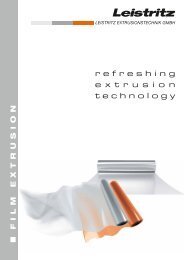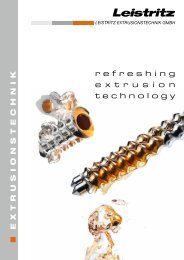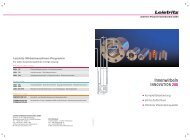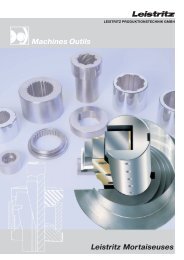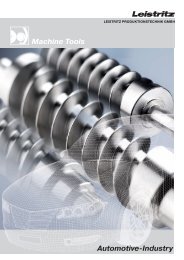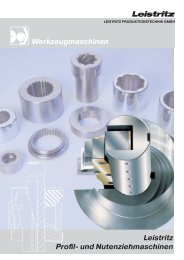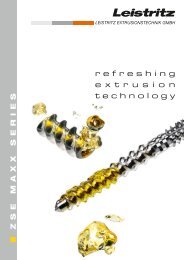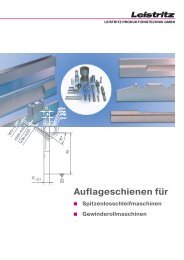und Messespiegel 1/2012 - Leistritz AG
und Messespiegel 1/2012 - Leistritz AG
und Messespiegel 1/2012 - Leistritz AG
Create successful ePaper yourself
Turn your PDF publications into a flip-book with our unique Google optimized e-Paper software.
M U L T I P H A S E P U M P S<br />
Twin Screw Multiphase<br />
Pumps and Slug Flow<br />
During the past decades the worldwide demand for crude oil and gas has continuously risen. Beside the<br />
well-known and proven production technologies new ways to increase the oil production had to be<br />
fo<strong>und</strong>. The revival of abandoned oilfields or further development and operation of marginal fields are<br />
considered by many producers.<br />
BY HANS-JÜRGEN SCHÖNER<br />
The majority of these fields produce<br />
high gas flows along with<br />
small amounts of hydrocarbons<br />
and water at very low well pressures<br />
that do not permit the use of<br />
conventional separation systems or<br />
even require artificial lift by means<br />
of downhole pumping equipment,<br />
gas lift or other technologies.<br />
Additionally, flaring and venting of<br />
so called Greenhouse Gas during<br />
the oil production contributes considerably<br />
to the climate change<br />
and the vast majority of oil producing<br />
countries has implemented<br />
statutory orders for the ending of<br />
flaring and venting.<br />
Hence, new ways of transferring<br />
the well flow to the processing<br />
facilities had to be introduced.<br />
Multiphase Flow<br />
In the early 1990s Twin Screw<br />
Pumps were employed for the first<br />
time to handle oil, water and gas<br />
mixtures, or in other words, “multiphase<br />
flow”, successfully. A large<br />
number of multiphase pumps<br />
have been installed over the past<br />
20 years. With their large operating<br />
range that covers many production<br />
years without equipment<br />
modification, the units have<br />
proven versatile, reliable and economical.<br />
Twin Screw Multiphase Pumps are<br />
rotary positive displacement<br />
Cut-a-way of a <strong>Leistritz</strong><br />
Twin Screw Multiphase<br />
Pump (illustrations/photos:<br />
<strong>Leistritz</strong> Pumpen GmbH)<br />
pumps. They are of double volute<br />
design and hydraulically balanced<br />
with no axial thrust on the bearings.<br />
After entering the pump suction,<br />
the flow splits and is pressurised<br />
within the opposed-thread<br />
screw packages. The screws are<br />
machined from single piece bar<br />
stock, hardened and installed in a<br />
replaceable casing insert. The<br />
torque from the drive screw is<br />
transmitted to the idler screw via<br />
oil lubricated timing gears. Both<br />
screws are not in contact with each<br />
other and carried in heavy duty<br />
and lifetime optimised tapered<br />
roller bearings.<br />
This makes Twin Screw Pumps<br />
particularly suitable to handle<br />
non-lubricating, contaminated<br />
and high viscous liquids (up to<br />
150,000 mm 2 /s) as well as products<br />
with high gas fractions. The<br />
shafts are sealed by single acting<br />
or double acting mechanical seals<br />
that are exposed to suction pressure<br />
only.<br />
Twin Screw Multiphase<br />
Pumps<br />
<strong>Leistritz</strong> Twin Screw Multiphase<br />
Pumps are available for maximum<br />
flow rates of 5,000 m 3 /h<br />
(755,300 bpd) and differential<br />
pressures up to 150 bar (2,175<br />
psi). They have a wide speed control<br />
range. By using frequency<br />
inverters it is possible to adapt the<br />
pumps easily to changing field or<br />
well conditions.<br />
Twin Screw Multiphase Pumps are<br />
designed to handle high Gas<br />
Volume Fractions (GVF) and to<br />
tolerate GVF fluctuations. Gas<br />
slugs with 100% GVF of different<br />
lengths must be expected in many<br />
applications. In order to maintain<br />
flow and pressure during slug flow,<br />
a liquid seal must be provided<br />
between screw tips and pump casing.<br />
Depending on the actual operating<br />
conditions a liquid rate of<br />
approximately 3.0 percent of the<br />
design flow must be injected to<br />
Clearances and liquid seal<br />
48 S C A N D I N A V I A N O I L - G A S M A G A Z I N E N O . 9 / 1 0 2 0 1 1<br />
assure sufficient gas compression<br />
during slug flow periods.<br />
Liquid Management<br />
System<br />
This is achieved with the external<br />
<strong>Leistritz</strong> Liquid Management<br />
System that can be designed for<br />
different gas slug lengths. For the<br />
majority of applications a system<br />
sized for gas slugs of 10 to 15 minutes<br />
is sufficient. Only a few applications<br />
require a liquid reservoir<br />
for approximately 30 minutes or<br />
even more. The external arrangement<br />
allows the installation of<br />
such oversized liquid reservoirs<br />
without problem. The Liquid<br />
Management System is located<br />
downstream of the pump discharge<br />
and within the skid limits.<br />
During the pump operation liquid<br />
is constantly separated from the<br />
multiphase flow with a minimum<br />
efficiency of 97 percent. The separated<br />
liquid is collected in the<br />
reservoir of the liquid management<br />
system and injected from the<br />
liquid reservoir into both suction<br />
areas of the pump.<br />
The large surface of the liquid<br />
reservoir supports quick heat dissipation<br />
and makes additional cooling<br />
unnecessary. For installations<br />
in cold environments space<br />
heaters, electrical heat tracing and<br />
insulation can be provided. The<br />
<strong>Leistritz</strong> Liquid Management<br />
System is equipped with a large



